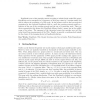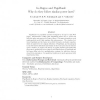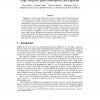PVLDB
2010
13 years 10 months ago
2010
In this paper, we analyze the efficiency of Monte Carlo methods for incremental computation of PageRank, personalized PageRank, and similar random walk based methods (with focus o...
ALT
2010
Springer
13 years 10 months ago
2010
Springer
Abstract. The importance of a node in a directed graph can be measured by its PageRank. The PageRank of a node is used in a number of application contexts
SIGIR
2002
ACM
14 years 3 months ago
2002
ACM
Two popular webpage ranking algorithms are HITS and PageRank. HITS emphasizes mutual reinforcement between authority and hub webpages, while PageRank emphasizes hyperlink weight n...
IM
2007
14 years 3 months ago
2007
PageRank is one of the principle criteria according to which Google ranks Web pages. PageRank can be interpreted as a frequency of Web page visits by a random surfer and thus it r...
IM
2007
14 years 3 months ago
2007
PageRank is a popularity measure designed by Google to rank Web pages. Experiments confirm that PageRank values obey a power law with the same exponent as In-Degree values. This ...
ITA
2006
14 years 3 months ago
2006
PageRank is a ranking method that assigns scores to web pages using the limit distribution of a random walk on the web graph. A fibration of graphs is a morphism that is a local i...
IM
2006
14 years 3 months ago
2006
Recent work on modeling the web graph has dwelt on capturing the degree distributions observed on the web. Pointing out that this represents a heavy reliance on "local" p...
NIPS
2001
14 years 4 months ago
2001
The PageRank algorithm, used in the Google search engine, greatly improves the results of Web search by taking into account the link structure of the Web. PageRank assigns to a pa...
TREC
2008
14 years 4 months ago
2008
PageRank is a way to rank Web pages taking into account hyper-link structure of the Web. PageRank provides efficient and simple method to find out ranking of Web pages exploiting ...
DAGSTUHL
2007
14 years 4 months ago
2007
PageRank is defined as the stationary state of a Markov chain. The chain is obtained by perturbing the transition matrix induced by a web graph with a damping factor α that spre...



